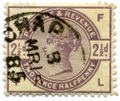
Queen Victoria Lilac and Green Issue
Encyclopedia

The postage stamp
Postage stamp
A postage stamp is a small piece of paper that is purchased and displayed on an item of mail as evidence of payment of postage. Typically, stamps are made from special paper, with a national designation and denomination on the face, and a gum adhesive on the reverse side...
s of the United Kingdom
United Kingdom
The United Kingdom of Great Britain and Northern IrelandIn the United Kingdom and Dependencies, other languages have been officially recognised as legitimate autochthonous languages under the European Charter for Regional or Minority Languages...
issued in 1883 and 1884 are known as the “Lilac and Green” issue because they were only printed in those two colours; lilac
Lilac (color)
Lilac is a color that is a pale tone of violet that is a representation of the average color of most lilac flowers. It might also be described as light purple. The colors of some lilac flowers may be equivalent to the colors shown below as pale lilac, rich lilac, or deep lilac...
being used for the ½d, 2d, 2½d, 3d values and dull green for the 4d, 5d, 6d, 9d and 1s.
New stamps were required because The Customs and Inland Revenue Act of 1881 necessitated stamps that were also valid as revenue stamps. Therefore the Penny Lilac
Penny Lilac
The Penny Lilac was the basic penny postage stamp of Great Britain from its first issue on 12 July 1881 and was used until 1901. It superseded the short lived Penny Venetian Red because the Customs and Inland Revenue Act of 1881 necessitated new stamps that were also valid as revenue stamps, and so...
issued that year was inscribed "POSTAGE AND INLAND REVENUE" and the Lilac and Green stamps were inscribed "POSTAGE & REVENUE", whereas the previous 1880 stamps (known as the Provisional Issue) were only inscribed "POSTAGE". The colours were used because the authorities were concerned that the existing stamps were being soaked off envelopes and reused
Postage stamp reuse
In the earlier days of the postage stamp, postal officials worried much about the problem of postage stamp reuse, and invented a number of schemes to mark or deface the stamps....
, and they wished to use fugitive inks
Fugitive pigments
Fugitive pigments are non-permanent pigments that lighten in a relatively short time when exposed to light. Fugitive pigments are present in types of paint, markers, inks etc., which are used for temporary applications...
that would wash away if immersed in water; the only fugitive ink colours available at the time were lilac and green.
The first stamp to be introduced was the 9d on 1 August 1883, which was rushed into use because there was an urgent need for a stamp of that value; the others followed on 1 April 1884. The designs featured Queen Victoria’s head in profile, with lettering in the corners. The 1½d, 3d, 4d, 5d and 1s stamps were in horizontal format and the 3d, 4d and 5d stamps were vertical.
The dull stamps were not popular, and the 1884 Stamp Committee was formed to make decisions about improved replacements. In 1887 they were superseded by the Jubilee Issue
Jubilee Issue
The postage stamps of the United Kingdom issued in 1887 are known as the "Jubilee" issue because they were issued during the year of the Golden Jubilee of the accession of Queen Victoria to the throne in 1837. They continued in use throughout the remainder of Victoria's reign, and many of the...
, with a variety of designs and colours.
Due to the fugitive nature of the ink, many surviving examples of the green stamps have lost their original colour following soaking to remove them from paper; the examples that still have good colour are the most sought after by philatelists.

